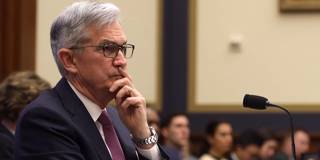The US Federal Reserve's surprise weekend announcement of a large interest-rate cut, renewed quantitative easing, and other expansionary measures is a welcome response to the COVID-19 pandemic. But as markets were quick to note, monetary policy cannot save us from this crisis.
NEW YORK – When interpreting the US Federal Reserve’s weekend announcement of new measures to mitigate the fallout from the COVID-19 pandemic, it is important not to confuse motion with action.
Arguably, the Fed’s latest move to ease monetary policy is unprecedented, not least because it was announced on a Sunday afternoon. The Fed cut the federal funds rate by 100 basis points (to the 0-0.25% range), which will likely translate into a meaningful reduction in the marginal cost of corporate and household borrowing from banks. The Fed is also reactivating quantitative easing (QE). In the coming months, it will increase its holdings of Treasury securities by at least $500 billion and its holdings of mortgage-backed securities issued by one of three quasi-governmental agencies (known as Ginnie Mae, Fannie Mae, and Freddie Mac) by at least $200 billion. And it will reinvest all maturing principal payments from these holdings in agency mortgage-backed securities.
In addition to these measures, the Fed also recently expanded its overnight repurchase-agreement (repo) operations and has announced that it will loosen capital and liquidity requirements for banks. But the most important part of the March 15 announcement was the promise to pursue “coordinated central bank action to enhance the provision of US dollar liquidity,” in partnership with the Bank of Canada, the Bank of England, the Bank of Japan, the European Central Bank, and the Swiss National Bank. To that end, the pricing of existing dollar-swap lines has now been lowered by 25 basis points; and, more significantly, foreign central banks will “begin offering US dollars weekly in each jurisdiction with an 84-day maturity, in addition to the 1-week maturity operations currently offered.”

NEW YORK – When interpreting the US Federal Reserve’s weekend announcement of new measures to mitigate the fallout from the COVID-19 pandemic, it is important not to confuse motion with action.
Arguably, the Fed’s latest move to ease monetary policy is unprecedented, not least because it was announced on a Sunday afternoon. The Fed cut the federal funds rate by 100 basis points (to the 0-0.25% range), which will likely translate into a meaningful reduction in the marginal cost of corporate and household borrowing from banks. The Fed is also reactivating quantitative easing (QE). In the coming months, it will increase its holdings of Treasury securities by at least $500 billion and its holdings of mortgage-backed securities issued by one of three quasi-governmental agencies (known as Ginnie Mae, Fannie Mae, and Freddie Mac) by at least $200 billion. And it will reinvest all maturing principal payments from these holdings in agency mortgage-backed securities.
In addition to these measures, the Fed also recently expanded its overnight repurchase-agreement (repo) operations and has announced that it will loosen capital and liquidity requirements for banks. But the most important part of the March 15 announcement was the promise to pursue “coordinated central bank action to enhance the provision of US dollar liquidity,” in partnership with the Bank of Canada, the Bank of England, the Bank of Japan, the European Central Bank, and the Swiss National Bank. To that end, the pricing of existing dollar-swap lines has now been lowered by 25 basis points; and, more significantly, foreign central banks will “begin offering US dollars weekly in each jurisdiction with an 84-day maturity, in addition to the 1-week maturity operations currently offered.”